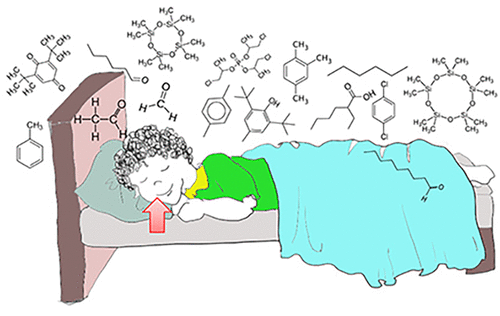当前位置:
X-MOL 学术
›
Environ. Sci. Technol.
›
论文详情
Our official English website, www.x-mol.net, welcomes your feedback! (Note: you will need to create a separate account there.)
Volatile Organic Compound Emissions from Polyurethane Mattresses under Variable Environmental Conditions
Environmental Science & Technology ( IF 10.8 ) Pub Date : 2019-07-10 , DOI: 10.1021/acs.est.9b01557 Kira Oz 1 , Bareket Merav 1 , Sabach Sara 1 , Dubowski Yael 1
Environmental Science & Technology ( IF 10.8 ) Pub Date : 2019-07-10 , DOI: 10.1021/acs.est.9b01557 Kira Oz 1 , Bareket Merav 1 , Sabach Sara 1 , Dubowski Yael 1
Affiliation

|
Sleeping microenvironment (SME), is characterized by higher temperature, humidity, and CO2 concentration. Emission of Volatile Organic Compounds (VOC) in SME is important considering the long duration people spend there with high proximity between their respiration inlets and potential emission sources, such as bedding material. This study concentrates on the influence of SME conditions on VOC emissions from polyurethane mattresses, and provides first approximation for inhalation exposure during sleep, based on measured emissions. Eight types of polyurethane mattresses were tested in a parallel continues-flow chamber system, to compare between VOC emission under different temperature, relative humidity, and CO2 concentrations. Contribution of mattress covers to emission fluxes was also examined. Eighteen VOCs were quantified with fluxes ranging from 10–4 to 10–1 mg/(h·m–2). Under sleeping conditions VOC emissions increased significantly. Elevated heat seems to be the major contributor to the enhanced emissions, compared to elevated relative humidity and CO2 concentration. Exposure levels estimated for sleeping child/infant indicate that SME can be a significant contributor to VOC exposure, yielding concerning exposure levels for few compounds. Furthermore, the present study demonstrates the strong dependency of sleeping person exposure on air exchange rate between his breathing zone and bedroom air (λBZ).
中文翻译:

可变环境条件下聚氨酯床垫中挥发性有机化合物的排放
睡眠微环境(SME)的特征在于较高的温度,湿度和CO 2浓度。考虑到人们在呼吸中花费的时间长,呼吸入口和潜在排放源(例如被褥材料)之间的距离非常近,因此,SME中挥发性有机化合物(VOC)的排放很重要。这项研究集中于中小企业条件对聚氨酯床垫VOC排放的影响,并基于测得的排放量提供了睡眠期间吸入暴露的第一近似值。在平行连续流室系统中测试了八种类型的聚氨酯床垫,以比较不同温度,相对湿度和CO 2下的VOC排放量浓度。还检查了床垫套对排放通量的贡献。定量了18种挥发性有机化合物,流量范围为10 –4至10 –1 mg /(h·m –2)。在睡眠条件下,VOC排放量显着增加。与相对湿度和CO 2浓度升高相比,热量升高似乎是造成排放量增加的主要因素。估计睡眠中的儿童/婴儿的暴露水平表明,SME可能是VOC暴露的重要因素,因此很少涉及化合物的暴露水平。此外,本研究表明,睡眠者暴露于其呼吸区域和卧室空气之间的空气交换率(λBZ)有很强的依赖性。
更新日期:2019-07-10
中文翻译:

可变环境条件下聚氨酯床垫中挥发性有机化合物的排放
睡眠微环境(SME)的特征在于较高的温度,湿度和CO 2浓度。考虑到人们在呼吸中花费的时间长,呼吸入口和潜在排放源(例如被褥材料)之间的距离非常近,因此,SME中挥发性有机化合物(VOC)的排放很重要。这项研究集中于中小企业条件对聚氨酯床垫VOC排放的影响,并基于测得的排放量提供了睡眠期间吸入暴露的第一近似值。在平行连续流室系统中测试了八种类型的聚氨酯床垫,以比较不同温度,相对湿度和CO 2下的VOC排放量浓度。还检查了床垫套对排放通量的贡献。定量了18种挥发性有机化合物,流量范围为10 –4至10 –1 mg /(h·m –2)。在睡眠条件下,VOC排放量显着增加。与相对湿度和CO 2浓度升高相比,热量升高似乎是造成排放量增加的主要因素。估计睡眠中的儿童/婴儿的暴露水平表明,SME可能是VOC暴露的重要因素,因此很少涉及化合物的暴露水平。此外,本研究表明,睡眠者暴露于其呼吸区域和卧室空气之间的空气交换率(λBZ)有很强的依赖性。












































 京公网安备 11010802027423号
京公网安备 11010802027423号